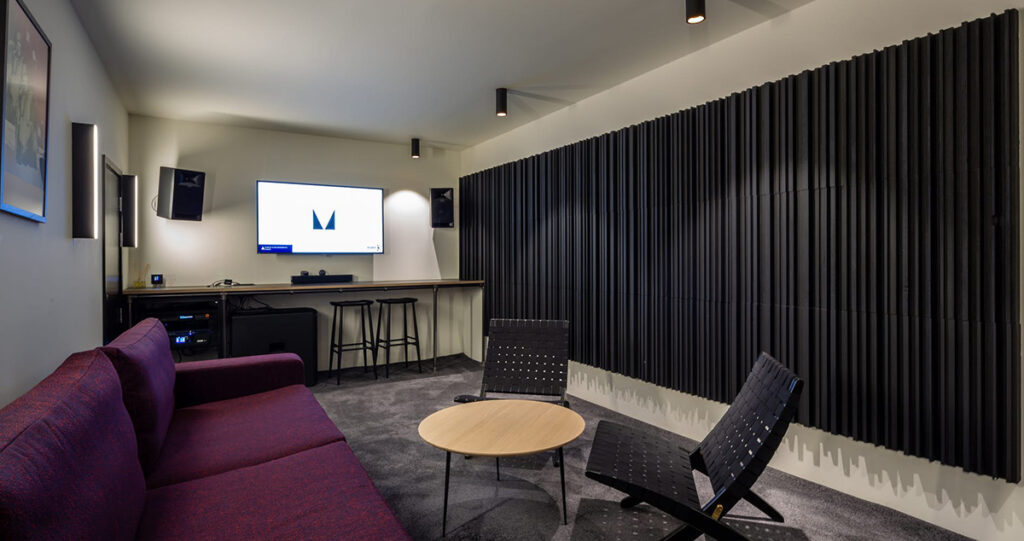Noise pollution can significantly affect our quality of life, especially in shared or private spaces like apartments and homes. Whether it’s the footsteps of an upstairs neighbour or the constant hum of traffic outside, unwanted noise can disrupt our daily routines and peace of mind.
Soundproofing comes in here, offering a solution that can transform noisy spaces into serene sanctuaries.
How Sound Travels in Homes and Apartments
Understanding how sound travels is key to effective soundproofing. Sound waves move through the air and solid objects, vibrating materials and causing noise to spread. In homes and apartments, sound can travel through walls, floors, ceilings, and even small gaps and cracks in the structure.
Identifying the Most Common Sources of Noise
Before starting on your wall soundproofing mission, it’s crucial to identify the most common sources of noise:
- External Noise: Traffic, construction, and other outdoor activities.
- Internal Noise: Voices, television, and household appliances.
- Structural Noise: Footsteps, plumbing, and HVAC systems.
Practical Tips for Effective Soundproofing
Soundproofing requires a strategic approach, focusing on key areas like walls, floors, and ceilings. Here’s how to do it effectively:
Focus Areas
- Walls:
- Use mass-loaded vinyl (MLV) or acoustic panels.
- Install double drywall with a resilient channel.
- Seal gaps and cracks with acoustic caulk.
- Floors:
- Lay down thick carpets or rugs.
- Use underlayment with soundproofing properties.
- Consider floating floors.
- Ceilings:
- Add a suspended ceiling with acoustic tiles.
- Use sound-absorbing materials like fibreglass or foam panels.
Best Materials and Techniques
- Mass-Loaded Vinyl (MLV):
- Ideal for walls and ceilings.
- Adds mass to prevent sound transmission.
- Acoustic Panels:
- Absorb sound waves.
- Easy to install and aesthetically pleasing.
- Resilient Channels:
- Decouple drywall from the structure.
- Reduce sound vibrations.
- Soundproofing Underlayment:
- Use under floors to minimise impact noise.
- Combine with carpets or rugs for best results.
DIY vs. Professional Soundproofing
- DIY:
- Cost-effective.
- Good for minor soundproofing needs.
- Requires some tools and materials.
- Professional:
- Best for extensive soundproofing.
- Offers expertise and high-quality results.
- More expensive but often worth the investment.
Where to Focus Wall Soundproofing Efforts for Maximum Effect
Rooms Most Affected by Noise
Certain rooms in your home are more susceptible to noise disturbances and benefit the most from soundproofing:
- Bedrooms:
- Ensure a peaceful night’s sleep.
- Soundproofing can help create a quiet sanctuary.
- Home Offices:
- Improve concentration and productivity.
- Essential for remote work environments.
- Living Rooms:
- Enhance entertainment experiences.
- Reduce noise from adjoining rooms or neighbours.
The Impact of Shared vs. External Walls
- Shared Walls:
- Common in apartments and townhouses.
- Soundproofing can minimise noise transfer between units.
- External Walls:
- Face the outside environment.
- Critical to block traffic and neighbourhood noise.
Techniques for Soundproofing Walls
- Adding Mass:
- Use additional layers of drywall.
- Combine with MLV for maximum effect.
- Decoupling:
- Install resilient channels or hat channels.
- Create an air gap to prevent sound transmission.
- Absorption:
- Use acoustic panels or foam.
- Absorb sound waves before they penetrate the wall.
Additional Soundproofing Tips and Considerations
Windows and Doors
While walls, floors, and ceilings are important areas to focus on, windows and doors can also be significant sources of noise ingress and egress. Here are some effective strategies to consider:
- Windows:
- Double Glazing: Installing double-glazed windows can create an additional barrier to noise.
- Window Inserts: Specialised inserts can be added to existing windows to enhance their soundproofing abilities.
- Heavy Curtains: Thick, heavy curtains or acoustic drapes can help block out noise and add an extra layer of insulation.
- Doors:
- Solid Core Doors: Replacing hollow-core doors with solid ones can significantly reduce noise transmission.
- Weatherstripping: Applying weatherstripping around door frames can seal gaps and prevent sound leakage.
- Door Sweeps: Installing door sweeps at the bottom of doors can block the gap and reduce noise from entering or leaving a room.
For optimal results, combine various soundproofing methods rather than relying on a single solution. For example, pairing acoustic panels with insulation and sealing gaps with acoustic caulk can greatly enhance the overall effectiveness of your efforts.
Conclusion
Soundproofing is a worthwhile investment that can greatly enhance your quality of life. You can create a quieter, more peaceful home environment by focusing on key areas and using effective materials and techniques.
Are you ready to take the next step in soundproofing your home? We encourage you to start small with DIY projects or consult a professional for comprehensive solutions. For more tips and resources, check out our website and join our community of noise-free living enthusiasts.
Share these tips with your friends, and let’s make the world a quieter place, one home at a time!

